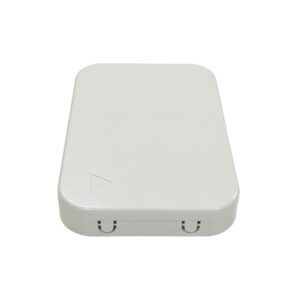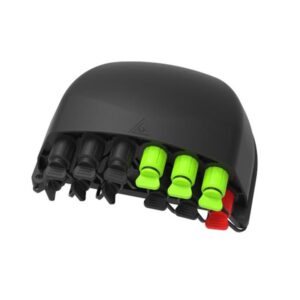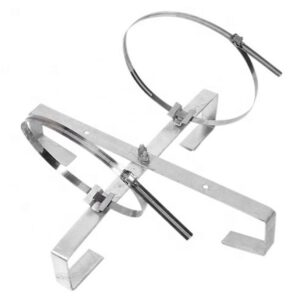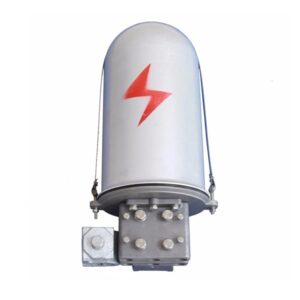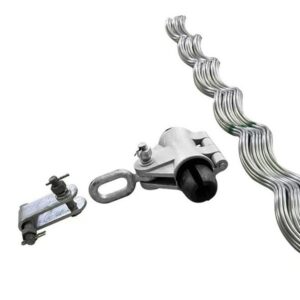The fiber-to-the-home (FTTH) optical cable line from the central room to the user is generally short-circuited in the trunk section, distribution section, introduction section and household section, as shown in Figure 1.

Generally speaking, the less the optical cable link segments, the better the security.
Why do FTTH optical cable link have to divide into so many sections?
1. If the optical fiber link from the central room to the user only passes through one optical cable segment (excluding fiber jumpers), that is, each user has to lay a direct cable directly to the central room, as shown in Figure 2. What is the problem?

There are two main problems here.
- There are many optical cables entering the central room, but the number of optical cables that can be allowed in an central room is limited;
- The distance for users to lay optical cables is long, which is inconvenient for installation.
Due to the above two limitations, the maximum number of users can allow access to is only dozens of households, and of course there are no application scenarios.
2. In order to solve the above problems, we make two improvements, as shown in Figure 3:
- Optical cables are exported from the central room using large-core cables, and then split into multiple small-core cables using optical joint closure; of course, if an optical cable has too many divergence points, it will affect the life and transmission indicators of the cable.
- Set up an optical distribution box in a location where users are concentrated as the dividing point between engineering and installation; when users do installation, they only need to lay a short section of optical cable from the outdoor cable distribution box to the user.

Assuming that an central room has 10 fiber optic cables, each cable is equipped with 6 to 12 fiber distribution boxes, and each optical distribution unit contains 8 users, the number of users served by an office is 480 to 960 households. At this time, the optical cable line from the central room to the user has become two optical cable segments: the central room to the fiber distribution box, and the fiber distribution box to the user. Since the connection relationship of optical fibers is fixed at the cable joint and the attenuation is small, the optical cable joint box is generally not used as the starting point of segmentation.
Compared with Figure 1, the number of end users of the central room in Figure 2 has increased several times, but the capacity is still too small; in addition, the development of users is dynamic. If a fiber distribution cabinet needs to be added to a certain location, it needs to be added from the central room again for rerouting the fiber optic cable.
3. It can be seen from the comparison between Figure 3 and Figure 2 that from the perspective of reducing the number of outbound cables and facilitating installation, the capacity of the central room can be improved by adding bifurcation points on the cables. There are two main types of divergence points of optical cables: optical cable cross cabinet (hereinafter referred to as “cabinet”) and splice closure.
An optical cable can be branched into multiple cables through optical cabinet. The number of branches is mainly limited by the laying conditions of the cable. The connection relationship between each cable is flexible, but it will increase the loss of the active connection and increase the fiber length. The difficulty of core management.
The number of cables that can be branched through the splice enclosure is small, generally no more than 6 ( 1 to 5 ). There are usually remaining optical cables on both sides of the joint enclosure. If there are many cables in a fiber optic splice enclosure, it will be messy and unsightly, as shown in Figure 4; Therefore, generally The number of branch cables will be controlled within 4 (1 minute 3) by a fiber closure .

After adding the cable cross cabinet on the basis of Figure 3, the optical cable network structure from the central room to the user is shown in Figure 5. Assuming that a cabinet ends with 10 incoming cables, each incoming cable is equipped with 6 to 12 splitter distribution boxes, and each fiber dp box houses 8 users, the number of users served by one cabinet is 480 to 960 households.

So how many optical cabinets can be set up in a central room?
Assuming that there are 10 cables in one central room and each cable is connected to an average of 3 optical cabinets, total cabinet quantity is 30. In this way, the capacity of a central room is about 14,400 to 28,800 households; such a large capacity can basically meet the needs of many scenarios.
Project construction will always be restricted by construction conditions. For example, if the optical cable network is to cover a residential community, the optical cabinet is best set up in the community. However, when constructing the backbone cable of a central room, most residential properties will not allow the construction in their communities, and by the time the marketing department negotiates the project construction conditions with a certain community, the backbone cable project will have been completed long ago.
The demand for engineering construction in residential areas, business buildings, and other clustered markets in the city is uncertain, and the construction of backbone cables must be completed within a certain period of time (usually 2 to 3 months). In order to solve this contradiction, during the construction of the backbone cable, the backbone cabinet is set up in a location that is close to the potential user groups, convenient for cable laying, and has installation conditions. When construction conditions are met in residential areas, commercial buildings, and other clustered markets, distribution cables should be installed at these locations, and distribution cables from the main branch to the distribution cable should be laid for communication, as shown in Figure 6. In this way, the optical cable line from the central room to the user is divided into as shown in Figure 1: the trunk section, the distribution section, the introduction section and the household section.

The cabinet setting can further increase the number of users that the central room can cover. So how many distribution cabinets can be placed under one trunk cabinet?
Yingda think 5 to 10 are suitable; if you only have 2 to 3 distribution cabinets, you might change the truck cabinet into splice closure.
At present, the fiber-to-the-home (FTTH) cable line from the central room to the user mainly has a 4-segment structure as shown in Figure 1, but we should also see that too many segments of the optical cable will deteriorate the quality of the optical fiber link and make the optical fiber The connection relationship of the link becomes complicated.
The separation of trunk cabinet and distribution cabinet is mainly to solve the problem of different construction timings of trunk cables and drop service cables in scenarios where the construction timing is not affected, such as when the coverage area ofa central room belongs to the same township or the same residence. It does not make sense to set up trunk optical intersections and wiring optical intersections separately.
Related products
Related Products
Related Products
1000mm Cable Storage Bracket For Pole With Stainless Steel Bands And Straps 19mm For Opgw Cable, Adss Cable
4 Port Metal Aluminum Joint Box With Steel Strips Opgw Cable, 72 Cores Fiber Splicing With Splice Cassette, Pole Mount, Tower Mount
Adss Cable Harga Suspension Clamps With Preformed Dead End Steels Strands
Adss Cable Spiral Shock Absorber 1000m Span, Highly Elastic Modified Pvc Plastic

